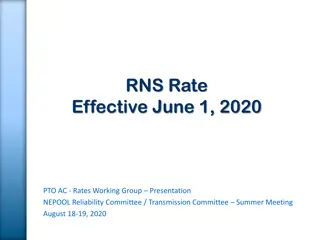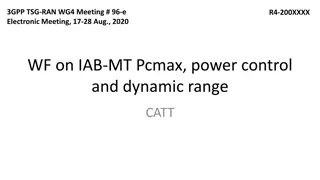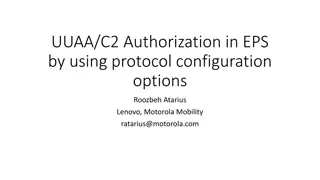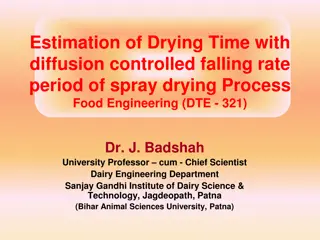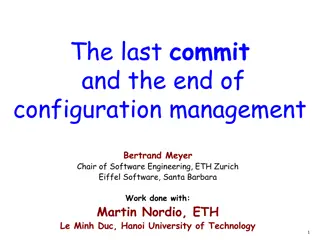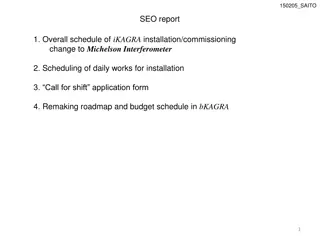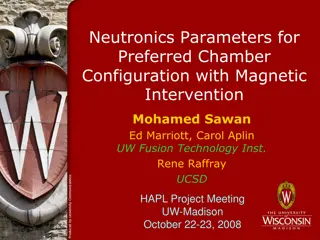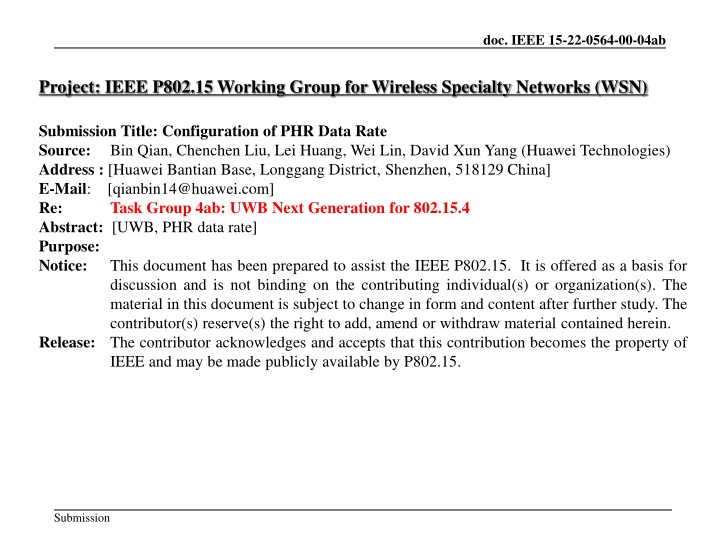
Dynamic Configuration of PHR Data Rate for Next Generation Wireless Specialty Networks
Explore the dynamic configuration of Packet Header Rate (PHR) data rate in IEEE P802.15 working group for Wireless Specialty Networks (WSN). This project by Huawei Technologies focuses on enhancing throughput, interference mitigation, and backward compatibility in high-density wireless environments. Various proposed solutions include improved link budget, additional channels, and advancements in accuracy and reliability for high-integrity ranging. The document highlights the importance of PHR data rate selection based on use cases and emphasizes reliability and reduced air-time for robust payload transmission.
Download Presentation

Please find below an Image/Link to download the presentation.
The content on the website is provided AS IS for your information and personal use only. It may not be sold, licensed, or shared on other websites without obtaining consent from the author. If you encounter any issues during the download, it is possible that the publisher has removed the file from their server.
You are allowed to download the files provided on this website for personal or commercial use, subject to the condition that they are used lawfully. All files are the property of their respective owners.
The content on the website is provided AS IS for your information and personal use only. It may not be sold, licensed, or shared on other websites without obtaining consent from the author.
E N D
Presentation Transcript
doc. IEEE 15-22-0564-00-04ab Project: IEEE P802.15 Working Group for Wireless Specialty Networks (WSN) Submission Title: Configuration of PHR Data Rate Source: Bin Qian, Chenchen Liu, Lei Huang, Wei Lin, David Xun Yang (Huawei Technologies) Address : [Huawei Bantian Base, Longgang District, Shenzhen, 518129 China] E-Mail: [qianbin14@huawei.com] Re: Task Group 4ab: UWB Next Generation for 802.15.4 Abstract: [UWB, PHR data rate] Purpose: Notice: This document has been prepared to assist the IEEE P802.15. It is offered as a basis for discussion and is not binding on the contributing individual(s) or organization(s). The material in this document is subject to change in form and content after further study. The contributor(s) reserve(s) the right to add, amend or withdraw material contained herein. Release: The contributor acknowledges and accepts that this contribution becomes the property of IEEE and may be made publicly available by P802.15. Submission
Slide 2 doc. IEEE 15-22-0564-00-04ab PAR Objective Safeguards so that the high throughput data use cases will not cause significant disruption to low duty-cycle ranging use cases Interference mitigation techniques to support higher density and higher traffic use cases Other coexistence improvement Backward compatibility with enhanced ranging capable devices (ERDEVs) Proposed Solution (how addressed) Dynamic PHR data rate configuration to reduce air-time and guarantee robust payload transmission Improved link budget and/or reduced air-time Additional channels and operating frequencies Improvements to accuracy / precision / reliability and interoperability for high-integrity ranging Reduced complexity and power consumption Hybrid operation with narrowband signaling to assist UWB Enhanced native discovery and connection setup mechanisms Sensing capabilities to support presence detection and environment mapping Low-power low-latency streaming Higher data-rate streaming allowing at least 50 Mbit/s of throughput Support for peer-to-peer, peer-to-multi-peer, and station-to- infrastructure protocols Infrastructure synchronization mechanisms Submission
November 2022 doc. IEEE 15-22-0564-00-04ab Introduction To support a variety of use cases, more additional data rates are under discussion in TG4ab Data rate candidates include 1.95 Mbps, 7.8 Mbps, 31.2 Mbps, 62.4 Mbps and 124.8 Mbps Besides the existing PHR data rates in 4z, three more PHR data rates are considered in [1] The principles to configure the PHR data rate Guarantee the reliability of PHR is higher than that of the PSDU Reduce the air time of PHR The existing out of band (OOB) signaling method is recommended in [1] PHR data rate can be selected depending on use case and updated until the next configuration OOB method works well in 4z [1] IEEE 15-22-0475-01-04ab-phr-content-and-rate Submission Slide 3 Bin Qian, et al
November 2022 doc. IEEE 15-22-0564-00-04ab Motivation The drawback of the OOB signaling method is the lack of flexibility. According to [2], it is beneficial to support the dynamic configuration of PHR rate to accommodate to the rapid change of devices requirement and channel conditions. A dynamic configuration method is proposed in [2]. The PHR is divided into a rate header (PHR1) sent at a fixed and low rate and a main header (PHR2) sent at a variable rate based on the PSDU modulation rate and FEC applied. This method allows the selection of PHR2 data rate across the range of 1.95 Mbps to 124.8 Mbps to better match the PSDU data rate Regarding the above method, there are two concerns The performance of PHR1 will be the bottleneck of the whole packet with some PSDU sizes when LDPC is applied. It is advantageous to have a performance gap between PHR and PSDU. The total air time of PHR1 and PHR2 is longer than that of PHR in [1] In this contribution, we propose to apply different SFD sequences to indicate the PHR data rate dynamically [2] IEEE 15-22-1476-01-04ab-a-phy-header-proposal Submission Slide 4 Bin Qian, et al
November 2022 doc. IEEE 15-22-0564-00-04ab SFD Indication Besides the role of the delimiter, SFD could also be used to indicate some information indirectly. For example, in the Clause 19 of IEEE 802.15.4-2020 (SUN FSK PHY), different SFD sequences are used for coded format and uncoded format, respectively. For ease implementation, the legacy SFD shall be kept to indicate the existing OOB signaling method. SFD indication is enabled by the OOB signaling. Additional SFD sequence is selected based on the following criteria Minimize the root mean square (RMS) of the correlation sidelobes Maximize the minimum distance, which is defined as the difference in amplitude between the main autocorrelation peak, and the worst case sidelobe Submission Slide 5 Bin Qian, et al
November 2022 doc. IEEE 15-22-0564-00-04ab SFD sequences with length 4 Selected SFD sequence Meaning Support [-1, -1, 1, -1] OOB configuration Mandatory (SFD No.1 in Table 15-7c in IEEE 802.15.4z-2020) [-1, -1, -1, -1] PHR rate 1 Optional [-1, -1, 1, 1] PHR rate 2 Optional [-1, 1, 1, -1] PHR rate 3 Optional The short SFD is used for the high data rates (e.g., 62.4 Mbps, and 124.8 Mbps) The values of PHR rate 1, PHR rate 2, and PHR rate 3 are TBD and can be determined by medium and high data rates (e.g., 31.2 Mbps, 62.4 Mbps, and 124.8 Mbps) Submission Slide 6 Bin Qian, et al
November 2022 doc. IEEE 15-22-0564-00-04ab SFD sequences with length 8 Selected SFD sequence Meaning Support [-1, -1, -1, 1, -1, -1, 1, -1] (SFD No.2 in Table 15-7c in IEEE 802.15.4z-2020) OOB configuration Mandatory [-1, -1, -1, -1, 1, 1, 1, -1] PHR rate 1 Optional [-1, -1, 1, -1, 1, -1, 1, -1] PHR rate 2 Optional [-1, -1, 1, 1, -1, -1, -1, -1] PHR rate 3 Optional The short SFD is used for the medium and high data rates (e.g., 31.2 Mbps, 62.4 Mbps, and 124.8 Mbps) The values of PHR rate 1, PHR rate 2, and PHR rate 3 are TBD and determined by medium and high data rates (e.g., 31.2 Mbps, 62.4 Mbps, and 124.8 Mbps) Submission Slide 7 Bin Qian, et al
November 2022 doc. IEEE 15-22-0564-00-04ab SFD sequences with length 16 Selected SFD sequence Meaning Support [-1, -1, -1, -1, -1, 1, 1, -1, -1, 1, -1, 1, -1, -1, 1, -1] (SFD No.3 in Table 15-7c in IEEE 802.15.4z-2020) OOB configuration Mandatory [-1, -1, 1, 1, -1, -1, -1, 1, 1, 1, 1, 1, 1, -1, 1, -1] PHR rate 1 Optional [-1, -1, 1, -1, -1, 1, 1, 1, 1, -1, 1, -1, 1, 1, 1, -1] PHR rate 2 Optional [-1, -1, -1, -1, -1, 1, -1, 1, 1, 1, -1, -1, 1, 1, -1, 1] PHR rate 3 Optional The long SFD is used for the medium and low data rate (e.g., 31.2Mbps, 7.8 Mbps) The values of PHR rate 1, PHR rate 2, and PHR rate 3 are TBD and can be determined by medium and low data rate (e.g., 31.2Mbps, 7.8 Mbps, 1.95 Mbps) Submission Slide 8 Bin Qian, et al
November 2022 doc. IEEE 15-22-0564-00-04ab SFD sequences with length 32 Selected SFD sequence Meaning Support [-1, -1 , -1 , -1 , -1 , -1 , -1, +1 , -1 , -1, +1, -1, -1 +1, -1, 1, -1, +1, -1, -1, -1, +1, +1, -1, -1, -1, +1, -1, +1, +1, -1, -1] (SFD No.4 in Table 15-7c in IEEE 802.15.4z-2020) OOB configuration Mandatory [-1, 1, 1, -1, -1, 1, -1, -1, 1, 1, - 1, 1, -1, 1, -1, -1, -1, -1, 1, 1, 1, 1, 1, 1, 1, -1, -1, 1, 1, 1, -1, -1] PHR rate 1 Optional [-1, 1, -1, -1, -1, -1, -1, 1, 1, 1, 1, -1, -1, 1, -1, -1, 1, -1, -1, 1, 1, 1, -1, 1, 1, 1, 1, -1, 1, 1, 1, -1] PHR rate 2 Optional [-1, -1, 1, 1, 1, -1, -1, 1, -1, 1, - 1, -1, 1, -1, -1, -1, 1, 1, 1, -1, 1, -1, -1, 1, 1, -1, 1, 1, 1, 1, 1, -1] PHR rate 3 Optional The long SFD is used for the medium and low data rate (e.g., 31.2Mbps, 7.8 Mbps, 1.95 Mbps) The values of PHR rate 1, PHR rate 2, and PHR rate 3 are TBD and can be determined by medium and low data rate (e.g., 31.2Mbps, 7.8 Mbps, 1.95 Mbps) Submission Slide 9 Bin Qian, et al
November 2022 doc. IEEE 15-22-0564-00-04ab Further Considerations Pros: by introducing more SFD sequences to indicate the PHR data rate, it is easy to achieve the matching of PHR data rate and PSDU data rate Avoid PHR becoming the performance bottleneck Avoid PHR lasting too long Cons: additional complexity is introduced by SFD detection at the receiver The PHR data rate, the PSDU data rate, the number of repeated preamble symbols and the SFD length need to be jointly optimized such that no part will become the performance bottleneck Submission Slide 10 Bin Qian, et al
November 2022 doc. IEEE 15-22-0564-00-04ab Summary This submission proposes an optional dynamic PHR data rate configuration method as a complement to the existing OOB method The SFD indication is signaled by OOB method Legacy SFD is used to indicate the OOB configuration of PHR data rate The joint optimization of the PHR data rate, the PSDU data rate, the number of repeated preamble symbols and the SFD length need further investigation Submission Slide 11 Bin Qian, et al
November 2022 doc. IEEE 15-22-0564-00-04ab References [1] IEEE 15-22-0475-01-04ab-phr-content-and-rate [2] IEEE15-22-1476-01-04ab-a-phy-header-proposal Submission Slide 12 Bin Qian, et al
November 2022 doc. IEEE 15-22-0564-00-04ab Appendix Submission Slide 13 Bin Qian, et al
November 2022 doc. IEEE 15-22-0564-00-04ab SFD Sequences Characteristics RMS of sidelobes and maximum positive sidelobe of SFD sequence set with length 4, where a, b, c, d denote the SFD sequence [-1, -1, 1, -1], [-1, -1, -1, -1], [-1, -1, 1, 1], [-1, 1, 1, -1] RMS x = a x = b x = c x = d 1.0690 1.6330 1.4606 1.4606 Preamble + a & x 1.1547 1.9272 1.5492 0.8944 Preamble + b & x 1.2649 1.6330 1.5119 1.4606 Preamble + c & x 1.5492 1.7127 1.3663 1.1952 Preamble + d & x maximum positive sidelobe Preamble + a & x x = a x = b x = c x = d 1 2 2 2 2 3 2 2 Preamble + b & x 2 0 2 3 Preamble + c & x 2 1 2 2 Preamble + d & x Submission Slide 14 Bin Qian, et al
November 2022 doc. IEEE 15-22-0564-00-04ab SFD Sequences Characteristics RMS of sidelobes and maximum positive sidelobe of SFD sequence set with length 8, where a, b, c, d denote the SFD sequence [-1, -1, -1, 1, -1, -1, 1, -1], [-1, -1, -1, -1, 1, 1, 1, -1], [-1, -1, 1, -1, 1, -1, 1, -1] and [-1, -1, 1, 1, -1, -1, -1, -1] RMS x = a x = b x = c x = d 1.6377 1.9344 1.6461 2.0000 Preamble + a & x 1.8316 2.1292 1.5240 2.3280 Preamble + b & x 2.0945 2.0656 1.9008 1.8316 Preamble + c & x 2.0635 2.1251 1.1914 1.9664 Preamble + d & x maximum positive sidelobe Preamble + a & x x = a x = b x = c x = d 4 3 2 4 2 3 4 4 Preamble + b & x 3 4 4 2 Preamble + c & x 4 4 2 3 Preamble + d & x Submission Slide 15 Bin Qian, et al
November 2022 doc. IEEE 15-22-0564-00-04ab SFD Sequences Characteristics RMS of sidelobes and maximum positive sidelobe of SFD sequence set with length 16, where a, b, c, d denote the SFD sequence [-1, -1, -1, -1, -1, 1, 1, -1, -1, 1, -1, 1, -1, -1, 1, -1], [-1, -1, 1, 1, -1, -1, -1, 1, 1, 1, 1, 1, 1, -1, 1, -1], [-1, -1, 1, -1, -1, 1, 1, 1, 1, -1, 1, -1, 1, 1, 1, -1] and [-1, -1, -1, -1, -1, 1, -1, 1, 1, 1, -1, -1, 1, 1, -1, 1] RMS x = a x = b x = c x = d 2.4097 2.7139 2.6904 2.8508 Preamble + a & x 3.1472 2.0635 2.5198 2.6667 Preamble + b & x 3.1673 1.9344 2.6186 2.7832 Preamble + c & x 2.9059 2.7255 2.7021 2.4230 Preamble + d & x maximum positive sidelobe Preamble + a & x x = a x = b x = c x = d 6 3 5 5 5 5 4 6 Preamble + b & x 3 6 5 5 Preamble + c & x 4 5 5 3 Preamble + d & x Submission Slide 16 Bin Qian, et al
November 2022 doc. IEEE 15-22-0564-00-04ab SFD Sequences Characteristics RMS of sidelobes and maximum positive sidelobe of SFD sequence set with length 32, where a, b, c, d denote the SFD sequence [-1, -1 , -1 , -1 , -1 , -1 , -1, +1 , -1 , -1, +1, -1, - 1 +1, -1, 1, -1, +1, -1, -1, -1, +1, +1, -1, -1, -1, +1, -1, +1, +1, -1, -1], [-1, 1, 1, -1, -1, 1, - 1, -1, 1, 1, -1, 1, -1, 1, -1, -1, -1, -1, 1, 1, 1, 1, 1, 1, 1, -1, -1, 1, 1, 1, -1, -1], [-1, 1, -1, -1, -1, -1, -1, 1, 1, 1, 1, -1, -1, 1, -1, -1, 1, -1, -1, 1, 1, 1, -1, 1, 1, 1, 1, -1, 1, 1, 1, -1] and [-1, -1, 1, 1, 1, -1, -1, 1, -1, 1, -1, -1, 1, -1, -1, -1, 1, 1, 1, -1, 1, -1, -1, 1, 1, -1, 1, 1, 1, 1, 1, -1] RMS x = a x = b x = c x = d 4.8436 4.0509 3.3999 3.3999 Preamble + a & x 5.6205 2.2748 3.8841 3.5627 Preamble + b & x 5.4498 3.1219 3.4732 3.4550 Preamble + c & x 5.5415 3.4275 3.8270 2.5511 Preamble + d & x maximum positive sidelobe Preamble + a & x x = a x = b x = c x = d 7 8 7 7 8 6 8 8 Preamble + b & x 7 8 7 8 Preamble + c & x 7 10 8 6 Preamble + d & x Submission Slide 17 Bin Qian, et al





